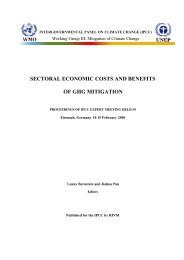Pacific Islands Environment Outlook - UNEP
Pacific Islands Environment Outlook - UNEP
Pacific Islands Environment Outlook - UNEP
You also want an ePaper? Increase the reach of your titles
YUMPU automatically turns print PDFs into web optimized ePapers that Google loves.
ACCESS TO GENETIC RESOURCES AND INTELLECTUAL PROPERTY RIGHTS<br />
57<br />
of greatest significance for long-term investments (e.g.<br />
port development, infrastructure, tourist hotels, tree crop<br />
plantations and forestry), where climate change ‘may<br />
stress a resource or ecosystem sensitive to climate<br />
change or have an effect on the ability of society to cope<br />
with climate change’ (Campbell and de Wet 1999).<br />
In a recent analysis for policy-makers (Campbell and<br />
de Wet 1999), three types of proposals were considered<br />
in terms of adaptation and development:<br />
1. Proposals in which the main objective is development.<br />
In these projects the adaptation component can be<br />
seen as additional, but necessary in order to ensure<br />
sustainability. Examples:<br />
● infrastructure development;<br />
● housing programmes;<br />
● agricultural development;<br />
● tourism development.<br />
2. Proposals that are specifically adaptation oriented.<br />
Examples include:<br />
● coastal protection;<br />
● developing drought/salt resistant crops;<br />
● public awareness programmes on the effects of<br />
climate change and on possible adaptive<br />
strategies.<br />
3. Proposals including capacity-building for dealing with<br />
the likely effects of climate change. Examples<br />
include:<br />
● institutional development;<br />
● human resource development, including:<br />
climate science training;<br />
technical training for adaptation;<br />
public awareness skills training.<br />
Overall, the optimal adaptation approaches will be<br />
anticipatory approaches that facilitate the inclusion of<br />
adaptation options in development.<br />
Access to genetic resources and<br />
intellectual property rights<br />
One emerging issue that will increase in importance is<br />
access to genetic material. As previously noted, this<br />
has already attracted commercial prospectors and, as<br />
the coverage of protected areas increases, there could<br />
be a growth in back-door or illicit dealings, such as<br />
happens world-wide with endangered bird and animal<br />
species. The steps that need to be taken at the<br />
legislative level are only one part of the response<br />
strategy. Conservation staff and managers of protected<br />
areas will need to work with local communities in order<br />
to build awareness and achieve co-operative<br />
surveillance.<br />
Threats to the region’s environment that could result<br />
from uncontrolled access include: excessive collecting<br />
that depletes the species being sampled, damage to the<br />
ecosystems where the sampling occurs, and the<br />
accidental spread of diseases or introduction of alien<br />
species in the process of collecting. Access should be<br />
managed, to ensure that collecting is sustainable and that<br />
the region’s ecosystems are conserved. Control could be<br />
achieved through a system of permits for bioprospecting,<br />
collecting and export, where permission is granted<br />
provided specified conditions are met.<br />
One mechanism for the country of origin to share in<br />
any benefits that may arise from use of the genetic<br />
resource is to require benefit-sharing as a condition of<br />
granting an access permit. Governments, private<br />
companies, individuals and local communities can benefit<br />
from the results of research, information on research<br />
methods, training, facilities, fixed payments and royalties.<br />
In the case of the TaroGen project commenced in 1998,<br />
participating PICs expect to benefit through improved<br />
conservation of taro varieties and the development of<br />
taro varieties that increase food production – the first<br />
goal is to develop taro varieties resistant to blight.<br />
Controlled access provides a means for parties to<br />
the Convention on Biological Diversity to balance their<br />
obligations under Articles 6 and 15. Parties have<br />
agreed, under Article 6, to ‘develop national strategies,<br />
plans or programs for the conservation and sustainable<br />
use of biological diversity’ and, under Article 15, to<br />
‘facilitate access to genetic resources……by other<br />
Contracting Parties’.<br />
Investors in genetic resources will usually seek<br />
intellectual property rights to protect their investment.<br />
Intellectual property rights include rights in relation to<br />
inventions, such as patent rights, copyright, plant variety<br />
rights, registered and unregistered trademarks including<br />
service marks, geographical indications, registered<br />
designs, confidential information (i.e. protection of<br />
undisclosed information in a commercial context,<br />
including trade secrets and know how), and all other<br />
rights resulting from intellectual activity in the<br />
industrial, scientific, literary or artistic fields. Note that<br />
patents give creators exclusive economic rights for only<br />
a limited time and act as an incentive to disclose<br />
information to the public. In contrast, trade secrets are

















